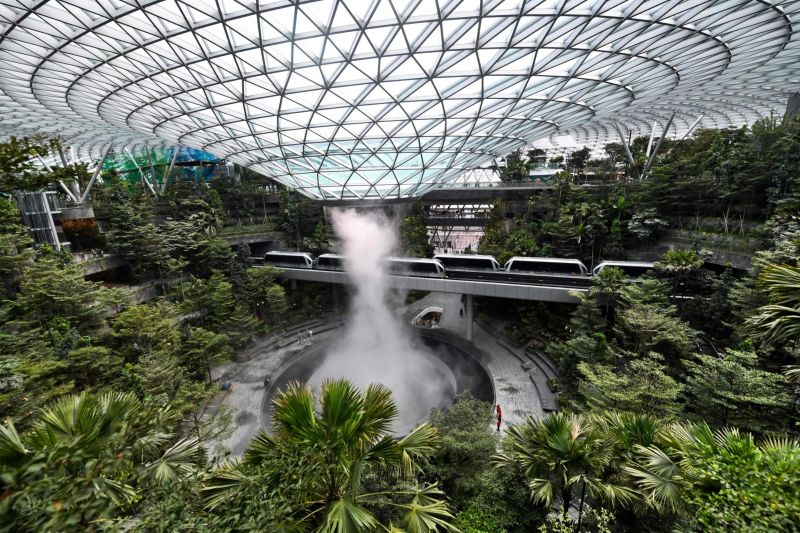
Changi Airport in Singapore Completes Stunning Transformation: Terminal 2 Fully Reopens

Singapore's Changi Airport reopens Terminal 2 after an impressive 35-year expansion, reaffirming its status as the world's best airport Discover the exceptional features that make it truly extraordinary
Terminal 2 at Singapore's Changi Airport has reopened after a significant expansion project that spanned over 3.5 years. This achievement is particularly remarkable considering the airport's recent recognition as the best airport in the world at the 2023 Skytrax Airport Awards.
The original terminal building has been expanded by 21,000 square meters (226,000 square feet), introducing extra infrastructure, new systems, and expanded shopping and dining options.
In the revamped T2, nature takes center stage as the main design theme. One of the standout features is a spectacular 14-meter-high digital waterfall display known as "The Wonderfall." Situated in the departure hall and framed by a vertical garden, this mesmerizing installation cascades over massive boulders.
Continuing with the nature theme, visitors in the departure transit area have the opportunity to admire the captivating Dreamscape garden. This captivating garden showcases a variety of plants that are brought to life by an innovative "digital sky," which dynamically changes colors according to the time of day.
In the near future, this exceptional airport will introduce a passport-free system, ensuring an even smoother travel experience for all passengers.
Meanwhile, Flap Pix is a captivating art installation that pays homage to the vintage charm of mechanical split-flap flight information boards, which were a common sight in airports of yesteryears. Created using 1,080 repurposed split-flaps, this installation is a must-see for travel enthusiasts seeking a nostalgic experience.
Changi T2's new 'Wonderfall" features 892 flat and flexi-curved tiles.
Changi Airport
Lye Teck, program director for the Terminal 2 expansion project at Changi Airport Groups, stated that with T2, their goal was to enhance the passenger experience by combining a modern terminal inspired by nature with immersive digital experiences, innovative technology, as well as transformative retail and dining concepts that impart a sense of place.
One of the new retail and dining experiences includes the two-story Lotte Duty Free Wine & Spirits, which features its own robot bartender. Above the bar, there is a 30-meter LED ring that depicts a moon reflecting in a lake. The Changi team explains that this artwork pays homage to the famous work "Drinking Alone Under the Moon" by Tang dynasty poet Li Bai.
The upper level features the Forest of Li Bai, an upscale lounge that boasts a selection of 18 whiskey options beneath an LED ceiling. Additionally, there is a smart selfie mirror available for visitors to capture pictures with renowned K-pop artists.
As for dining, there are new additions such as Gourmet Garden, which provides stunning views of the airport's apron and serves Singaporean delicacies including Satay Club by Harry's and Wee Nam Kee Chicken Rice.
The T2 expansion project, initiated in January 2020, has increased Changi's passenger capacity by 5 million, resulting in a total handling capacity of 95 million passengers per year, as stated by the airport. This terminal serves as a hub for sixteen airlines, providing connectivity between Singapore and 40 cities.
What makes the best airport so great?
Video Ad Feedback
Inside Singapore's Jewel Changi Airport
02:39
- Source:
Singapore Changi Airport, previously ranked as the best airport for eight consecutive years by Skytrax, experienced a temporary decline in its position in 2021 and 2022 due to a decrease in passenger numbers caused by the pandemic. However, it reclaimed its title as the top airport in the recently announced awards for this year, with Hamad International Airport in Doha, Qatar being surpassed in the rankings.
Since its opening in 1981, Paya Lebar airport has undergone significant changes. A major milestone was the construction of Terminal 2, which commenced in 1986 as a response to the growing number of passengers. This new facility was then made available to travelers in 1991.
The worlds best airports for 2023, according to Skytrax
But it was the introduction of some previously unheard-of amenities that really got the worlds travelers to take notice.
In 1995, Changi Airport introduced the world's first transit-area swimming pool, which initiated a series of additions that set it apart from other global airports. These additions included a news hub, a movie theater, and a sports arena, all implemented in 1998.
Changi Airport Terminal 3 introduced its 12-meter-high mega slide and butterfly garden in 2008, while Terminal 4 opened in 2017. Following these developments, Changi Jewel was unveiled in 2019, providing a compelling reason for locals to visit the airport even if they do not have any travel plans.
Changi Airport, renowned for its awe-inspiring design, is set to undergo a remarkable expansion, effectively doubling its current size. This extraordinary 135,700-square-meter space boasts an eye-catching, circular structure crafted with a combination of steel and glass. Serving as a versatile facility, it seamlessly links three out of four terminals at Changi Airport.
The main highlight of this place is the HSBC Rain Vortex, a magnificent indoor waterfall that stands at a height of 40 meters. It gracefully flows through a massive oculus located in the center of the structure, proudly claiming the title of the world's tallest indoor waterfall.
In addition, you will find an IMAX theater with 11 cinema halls and the Shiseido Forest Valley, a charming four-story garden that features picturesque walking trails. All these attractions complement the mesmerizing presence of the Vortex waterfall.
Starting in 2024, Changi Airport officials have announced a new development for the renowned hub - automated immigration clearance. This innovative system will enable passengers to leave the city-state without the need for passports, relying solely on their biometric data.
Furthermore, plans for Terminal 5 have already been unveiled by airport authorities. It is anticipated that this advanced terminal will be accessible to travelers by the mid-2030s. Further information regarding this project can be found here.








